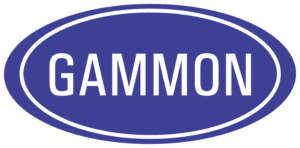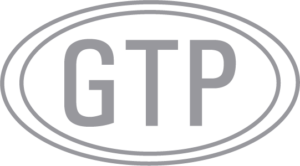Our Founder
Howard McKee Gammon
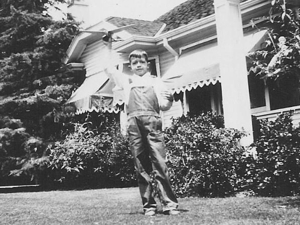
Howard playing with a toy airplane as a child.
Howard was born in Los Angeles in 1922 to James Mathias Gammon and Carrie Bernice McKee. He and his younger brother Newt were raised to be hard workers, like their father who, although he lost his father as a child and grew up on a small farm in Iowa, put himself through law school.
Howard held as many as three newspaper routes at a time, including delivery to a movie studio and famous residences in the Hollywood hills. Riding his paper routes gave him strong legs and he was a star runner in high school track and field. His interest in all things mechanical earned him an unpaid (at first) part-time job in a machine shop. He taught himself surveying using a transit he bought in a pawn shop. He also had a summer job at Douglas Aircraft, working as an engineering assistant on the Douglas DC3, perhaps the most famous transport aircraft ever built. He learned to be an automobile mechanic and worked on cars to make extra income while still in high school.
Howard attended community college but World War II intervened and he joined the Army Air Corps, later to become the US Air Force. He asked to be a navigator because of his interest in science and mathematics. He did so well in school that they made him a navigation instructor. He married Claudia Overington Newman of Philadelphia during this period of time.
He kept applying for combat and was finally assigned to the 319th Bomber Group and sent to Okinawa to fly as navigator, bombardier, and co-pilot for the unit commander, Col. Randy Holtzaple in Douglas A-26 attach aircraft. He flew five combat missions over Japan before the war ended.
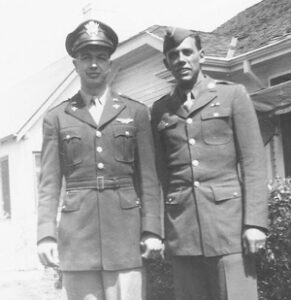
Howard and his brother Newt in uniform.
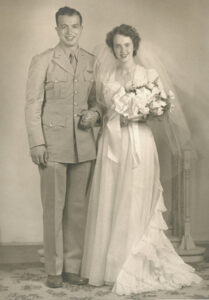
Howard and Claudia on their wedding day.
After the war, he put himself through college at his father’s Alma Mater, the University of Iowa, earning a degree in Mechanical Engineering. He took a job with Westinghouse, assigned to supervise installation of the first nuclear reactors into submarines. Delays left him with nothing to do, so he volunteered to work on the prototype reactor in Idaho Falls. He designed and ran the first nuclear decontamination of equipment removed from the reactor. This drew the attention of Admiral Rickover, who insisted that Howard be re-assigned to be in charge of decontamination projects for the Navy. Howard didn’t want that job and left Westinghouse, taking a job with Thompson Products (now known as TRW). He first worked in and then ran a test lab in California, later running the engine parts development lab in Cleveland, Ohio.
He then took a job as Chief Engineer at Purolator Filters in New Jersey, but yearned to own his own business. He left Purolator and took several positions as a manufacturer’s representative, selling engineered products to NASA in the early years of the space program. While in this field, he met a fiberglass salesman who wanted to make filters to remove water from jet fuel using fiberglass. Howard knew well how to build filters and went to work for Lou Taylor and the company that would become Velcon Filters. Howard himself coined the name “Velcon” as a portmanteau based on the term “velocity-control,” the critical aspect of removing/coalescing water from hydrocarbons.
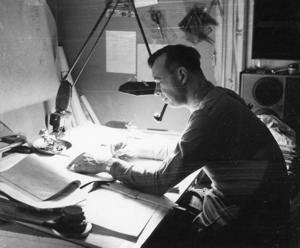
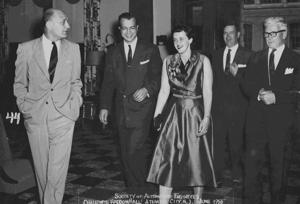
SAE, June 1955
Howard’s contributions to aviation fuel quality control world-wide are impossible to quantify. His designs are used in virtually every airport in the world, large and small – as well fuel terminals and refineries serving airports. Among many other volunteer positions in the industry, we was chairman of the ASTM Avgas committee for so long that when he retired from it, no one knew when he had started, no one else had been there that long.
Few engineers working in the pumping of fluids are aware of his contribution, what we call “Gammon’s formula”. He figured out how to simply calculate fluid velocity in a pipe in feet per second (fps). All you needed to know was gallons per minute and pipe size. (GPM/pipe size squared) x 0.4 = fps.
His “Gammon Gauge” is used around the world, the only direct reading differential pressure indicator design that never needs to be laboratory calibrated, requiring just a simple, in-place check by the operator.
His creative and innovative engineering lives on with Jim Gammon, his son, now running Gammon Technical Products for 15 years – although Howard never retired. Jim’s wife Wanda has also been a major part of the family business for over 40 years, and their daughter Sandra has been working there for three years, learning the business.
Howard and Jim together wrote over 60 educational “GamGrams”, considered “must reading” for anyone getting into jet fuel or Avgas fuel quality control.

Howard and Claudia on vacation.
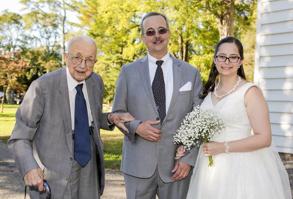
Howard, Jim, and Sandi Gammon at Sandi's wedding in 2016.
Howard passed away peacefully in his sleep, at home in his own bed at the age of 95 years and 10 days. Howard is survived by his daughters Mary and Jeanne Gammon, his son Jim Gammon and daughter-in-law Wanda Gammon, his grandson Jimmy Gammon, and his granddaughter Sandi Gammon, as well as Sandi’s husband Tim Sigler. His wife Claudia predeceased him in 2014, and his brother Newt in 2005.
Howard accomplished his life’s goal, to make a difference in the world. Howard truly is the father of aviation fuel quality control and a father figure to many aviation fuel handing experts around the world. He is well remembered by his family, as well as thousands of friends across the world.
